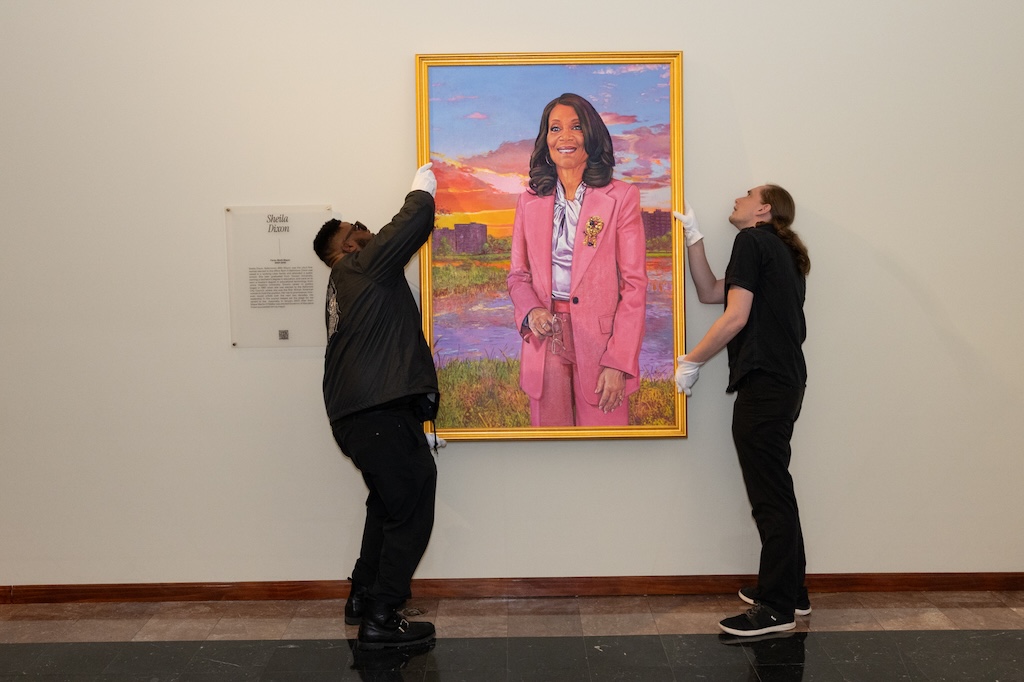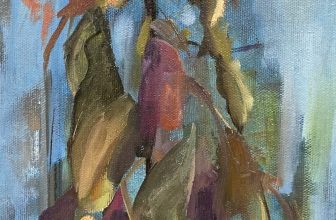
When you visit a museum, you often find yourself surrounded by large portraits of powerful individuals from a variety of historic time periods. Even if you don’t know exactly who the sitter is, it’s easy to note their ornate clothing and jewelry or other meaningful details on and around them.
What you typically do not think about is the point of view of the artist who created the portrait, what kind of personal message they are sending, or creative liberties they may have taken. Every work of art tells a story and even official commissioned portraits reflect the artist’s perspective, values, and approach. This means that historic portraits, no matter how official, often contain specific symbols and subversive plotlines embedded into the composition. The artist, not the person hiring them, gets the last word in terms of visual legacy. It’s an awesome power, and one reason I agreed to be a part of the committee to vet and select artists to paint the portraits of the past five mayors of Baltimore.
On Saturday, November 1, that process came to a culmination when four portraits of former mayors were unveiled in a City Hall ceremony called “Portraits of Power.” The former mayors depicted in the portraits include Sheila Dixon (Baltimore’s 49th mayor, 2007 to 2010), Stephanie Rawlings-Blake (50th mayor, 2010 to 2016), Catherine Pugh (51st mayor, 2016 to 2019) and Bernard C. “Jack” Young (52nd mayor, 2019 to 2020). Our competition also included a commission for our current mayor, but that will be unveiled at a later date.


Originally an initiative conceived of by Tonya Miller Hall, formerly the Senior Advisor for Arts and Culture for Mayor Scott, the “Faces of Leadership” portrait competition drew more than 180 submissions from artists around the region. After a lengthy jurying process, the committee—including myself, former MICA President Samuel Hoi, artist and Co-Director of BmoreArt’s Connect+Collect initiative Jeffrey Kent, and former AVAM director Jenenne Whitfield—narrowed it down to twenty-five applicants.
From there, we shared the submissions with each of the five mayors and former mayors, who selected their top choices. In the end, the selected artists were Andrew Pisacane, also known as Gaia, for Dixon’s portrait; Megan Lewis for Rawlings-Blake’s portrait; Kennedy Ringgold for Pugh’s portrait; and Karen Warshal for Young’s portrait. Ernest Shaw was selected to paint the portrait of Mayor Brandon Scott.
Each artist was paid $20,000 for their labor, which included their art materials and supplies, as well as their time; each was required to attend multiple meetings with their portrait subjects, submit ongoing sketches, and to participate in a painting process over the course of the year that included review by the committee and the former mayor. In the world of artist commissions and honorariums, this is a fair price. Given the timeline and expectations, it was generous enough to attract appropriate talent. But for any taxpayers balking at the price tag: consider how much less these portraits cost compared to those commissioned for business or world leaders. The selection of Baltimore artists also kept those dollars local and supports the city’s creative ecosystem.


Joe Tropea, Curator for the Mayor’s Office in Baltimore City, started his first week at City Hall when the project had just gotten underway. He played an important role in keeping the process going, acting as a liaison between each artist and former mayor. “I organized a luncheon for them and provided an opportunity for the artists and subjects to spend some time with the Mayoral Portrait collection in the BOE room,” he says. “After that, my work involved making sure artists (and mayors) were staying on track and hitting their benchmarks such as sending sketches for approval by the subject/mayor and committee. There were some challenges along the way. One of the artists slipped on ice and broke her wrist, which set things back slightly. But I’m happy to report that the project culminated within our timeline, more or less.”
For me, it was important that each subject of the painting felt properly seen and heard, but also that each artist was able to draw from their own set of creative gifts and insights in order to create truly memorable and unique portraits. Rather than a traditional, predictable outcome, each portrait, by a Baltimore-based artist, reflects our shared experience and highlights aspects of Baltimore City alongside the accomplishments of each mayor.




For many of the subjects, this was their first time interacting with an artist. The process required clear communication and trust on the part of both artist and mayor, and was an opportunity for each former politician to understand more about the complexity and labor required to do such a job.
On Saturday, November 1, a “Portraits of Power” ceremony took place in the Baltimore City Hall Rotunda, and included Mayor Scott and his family, the last four former mayors, the artists, and well wishers. According to Ed Gunts at the Baltimore Fishbowl, “A fifth former mayor, Martin O’Malley, was in the audience. O’Malley, 62, was the last Baltimore mayor (1999 to 2007) to have his portrait painted before Scott launched the competition.”
According to Tropea, in all there are 30 known portraits of former Baltimore City mayors, with two in storage, in need of conservation. There are two on loan to the Maryland Center for History and Culture (MCHC). “The earliest portrait that we know of is of Baltimore’s third mayor, Edward Johnson (1808-1816),” says Tropea. “We believe this is when the tradition of mayoral portraits started in Baltimore—sometime near or around 1816. I believe MCHC has this painting as well as the original of Mayor Samuel Smith in their War of 1812 exhibition (longterm loan). The City has a portrait of Baltimore’s first mayor, James Calhoun (1797-1804), however, it’s a replica of another painting that was commissioned by the City, possibly in or after 1816. Aside from the four new portraits, the most recent one is of Mayor Martin O’Malley painted by Jorge Alberto in 2010.

I was unable to attend the unveiling because the date was the same as the BmoreArt Icons Ball, but I was definitely there in spirit, cheering on the artists who worked so diligently to create a new piece of art history for Baltimore. Now that they are finished, these portraits will continue to form a collective historic record and will be displayed in the Hyman Aaron Pressman Room of City Hall (and the room leading into it), alongside paintings of 26 former mayors. Through December , the portraits will hang in the North Gallery, a diverse and dynamic example of what Baltimore-based artists are capable of, when given the opportunity.
“As a curator and historian, and especially as someone whose job is to give tours of City Hall, I think portrait representation is important because it preserves and helps us understand the history of our city,” says Tropea. “Even more so with them collected together in one room (gallery). You can tell someone about a leader or public figure, but having a visual representation that the leader had a part in creating makes the story (history) much more compelling and easier to understand.”








